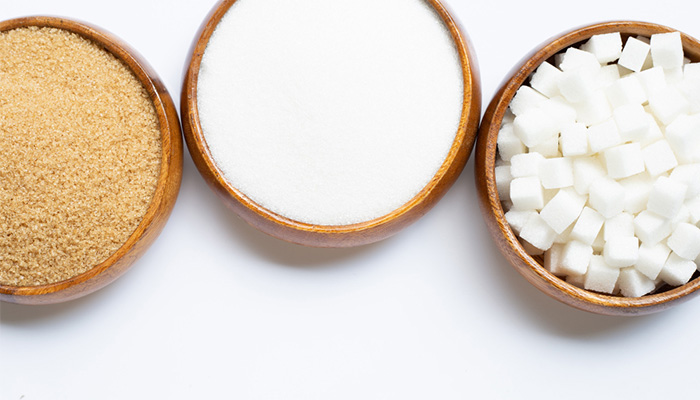Everyone is born with a sweet tooth, and there is scarcely anyone who does not enjoy eating sweets. Even babies prefer sweeter fruits to bland veggies and meat. For some, the sweet tooth that we are born with becomes a lifelong fixation, resulting in excessive sweet food consumption and eventually detrimental health concerns. The real issue is not eating naturally sweet foods but rather consuming too much added sugar, which has become an essential part of our daily diet. Consuming too many sugary foods can lead to diabetes and other health problems. This page will provide basic information regarding added sugars and their benefits and drawbacks.
Understanding sugars
When someone asks, ‘What is sugar?’ The most common straightforward answer is: They are sweet, white crystals used to give food a sweet flavour. Technically, sugars are carbohydrates and sweeteners that are added to foods and beverages to produce a sweet taste, texture, body, and bulk. It also contains a lot of calories; hence, it is also known as a caloric sweetener. Sugars are of two types: those that exist naturally in food and those that are added to foods and beverages to make them taste sweeter.
Difference between natural and added sugar
Sugar in our diet can be either natural or added. Natural sugar can be found in fruits, vegetables, unprocessed foods, milk, and certain grains. Fructose in fruits and lactose in milk and milk products are examples of naturally occurring sugars.
Added sugar is sugar that is added to foods or beverages during the manufacturing process to give them a sweet taste. Sugar added in our kitchen is likewise classified as an added sugar product. Processed foods and beverages contain both naturally occurring sugar (fructose) and added sugars such as high-fructose corn syrup. Ice cream, some breakfast cereals, cookies, pastries, fruit drinks, and other processed meals include added sugars.
Use of added sugar
It is natural to think that if added sugar does not provide any nutrition, then what is the purpose of adding it to so many foods and drinks? Added sugar does serve many other purposes in food processing. They:
- Contribute to the texture and structure of food.
- Are very good preservatives that preserve jellies and jams.
- Give bulk to ice cream.
- Control crystallization.
- Aid in the fermentation of bread and alcohol.
- Maintain the freshness of bread and other baked items.
- Give a more appealing taste to foods and drinks.
- Balance the acidity in foods containing vinegar and tomatoes.
Importance of limiting added sugar
The American Heart Association has surveyed and stated that the average person consumes around half a cup of added sugar every day. This excludes the natural sugar obtained from fruits, vegetables, milk, and milk products. Too much sugar can be harmful to one’s health. Many people are unaware of how much sugar they consume, and as a result, they consume more sugar than is necessary. Our bodies do not require sugar to function properly; therefore, reducing sugar consumption is critical. Furthermore, added sugar has no nutritional value and may result in a lack of nutritional supply, but it contains unwanted calories that can add up to a few extra pounds and may result in weight gain, reducing the chances of having a healthy heart.
Too much added sugar can also cause dental decay, higher triglyceride levels, problems regulating type II diabetes, and a decrease in good cholesterol (high density lipoprotein, or HDL). As a result, it is critical to increase natural sugar consumption while limiting added sugar. People who eat added sugar are reported to be less inclined to consume healthy foods. They tend to consume more soda or added sugar beverages, which have no nutrients but just a lot of calories. It is suggested to replace them with milk, which gives the body calcium and other proteins and minerals.
Now we know what added sugars are and what they do. Now the important question is: how much added sugar should one consume? Added sugars are known to have increased the rate of obesity and heart disease; therefore, to minimize such complications arising from increased added sugar consumption, the American Heart Association (AHA) has published guidelines for eating added sugar. The AHA suggests no more than 6 teaspoons or 24 grams (100 calories) of added sugar per day for women and no more than 9 teaspoons or 36 grams (155 calories) of added sugar per day for men.
Tips to know the amount of added sugar in food or drink
Soft drinks and sugary fruit drinks are the main sources of added sugar. Check the nutritional information label to see if a packaged item contains sugar and how much sugar is there. Since the amounts of added sugar and natural sugar are reported as total grams of sugar, record the total sugar in a single serving. Remember that 1 gram of sugar contains 4 calories, and 4 grams of sugar equals 1 teaspoon; thus, if the food product includes 15 grams of sugar per serving, the quantity of calories from sugar alone is 60 per serving, disregarding other ingredients. Some products bear the label “sugar free” or “no added sugar”. Beware of such products, as they may contain sugar substitutes.
On the label, added sugar may be mentioned in a variety of terms. Aside from names that end in “ose,” such as fructose, maltose, glucose, sucrose, dextrose, and lactose, they can also be mentioned as fructose corn syrup, molasses, corn sweetener, raw sugar, cane sugar, syrup, honey, fruit juice concentrates, confectionary sugar, granulated white sugar, invert sugar, and malt syrup.
Tips to avoid extra sugar
The first step in avoiding too much added sugar in your diet is to identify which items contain added sugar. Products that contain high amounts of added sugars are sugary drinks, such as soft drinks, sports drinks, and fruit drinks; non-diet soda; candies; sweetened milk; dairy goods; ice cream; sweetened yoghurt; sugar sweetened cereals; honey-nut waffles; cakes, cookies, and pies; and cinnamon toast.
Here are a few tips to help you avoid eating too much sugar:
- Stop eating all foods and beverages that contain added sugar.
- Substitute sugar for artificial sweetener.
- Use only sugar-free or low-caloric beverages.
- Consume fresh fruits or fruits canned in water.
- Avoid fruits canned in syrup.
- Replace sugar with fresh fruits like bananas, cherries, and strawberries, or dried fruits like raisins or apricots.
- Cut the sugar content by half or one-third in baking items like cakes and cookies.
- Instead of sugar, use almond, vanilla, orange, or lemon extracts.
- Instead of sugar, use almond, vanilla, orange, or lemon extracts.
- Eat healthy foods like fruit, vegetables, low-fat dairy products, high-fiber whole grains, poultry, and fish.
- Replace low-fat milk with sweetened soda and beverages.
- Drink water instead of sugary drinks.
- Avoid processed foods that are not only rich in added sugar but also rich in fat and sodium.
- Have fresh fruits or sweet potatoes for dessert.
- Eat whole grain bread and pasta.
- Learn the names of all sugars and how to read the label on food products.
- Choose low-sugar jams, jellies, and preserves.
- Avoid ice cream and sweetened yoghurt as desserts.
- Do not prefer blended coffee with flavoured syrup and sweet toppings.
Conclusion
It is true that the consumption of sugary foods causes health problems in the long run. However, sugary foods also contribute to nutritional shortages, which are essential for the body’s healthy functioning. It is critical to track your daily calorie intake and create a balance between being healthy and falling down a downward slope of illnesses.



